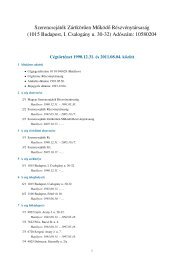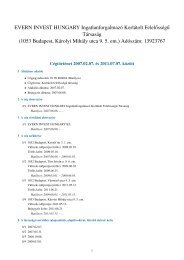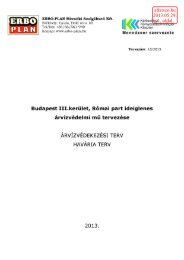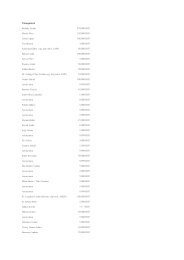THE BLACK BOOK OF AUSTRIAN AGRICULTURE - atlatszo.hu
THE BLACK BOOK OF AUSTRIAN AGRICULTURE - atlatszo.hu
THE BLACK BOOK OF AUSTRIAN AGRICULTURE - atlatszo.hu
You also want an ePaper? Increase the reach of your titles
YUMPU automatically turns print PDFs into web optimized ePapers that Google loves.
<strong>THE</strong> <strong>BLACK</strong> <strong>BOOK</strong><strong>OF</strong> <strong>AUSTRIAN</strong><strong>AGRICULTURE</strong>A new book uncovering farm subsidies, tax breaksand other agricultural intrigues has caused a politicalstorm and shaken the Austrian establishmentJANUARY 2011Lutz Mükke and Piet Felberlutzmuekke@aol.comANEU TRANSPARENCYINITIATIVE
In “The Black Book of Agriculture – theintrigue of agricultural politics”, HansWeiss tries to find a way through theseemingly impenetrable world of Austrianfarm subsidies.* Judging by the response,Weiss, whose previous exposés of thechemicals and pharmaceutical industriessold more than five million copies, was onthe right path. The book made headlines inAustria, found itself on the nightly news,and topped the bestseller chart. As Weissputs it: “The farming bureaucracy foamedat the mouth.”Take the head of Austria’s largest farmingunion, Fritz Grillitsch, a member of ÖVP, aconservative political party. He claimed notonly that Weiss probably wrote the bookunder instruction from the Austrian SocialDemocratic Party (SPÖ) but also that he wasa convicted criminal. Moreover, Grillitschthreatened to sue Weiss.The book has eight chapters. In some,Weiss provides facts and figures aboutsubsidy-related practices and tax tricks; inothers, he introduces us to people withfirst-hand experience of the opaque worldof agriculture subsidies or victims of thedeteriorating circumstances of subsidyfarming. The contrast makes for a detailedyet colourful account.In the foreword, Weiss provides examplesof the inequity of farm subsidies in Austria.He identifies prominent “mountainfarmers” who also happen to be householdnames such as the business leadersWolfgang Porsche, of the sports cars, andDietrich Mateschitz, the inventor of theRed Bull energy drink. Both benefit fromfarm subsidies, albeit on a rather low level,but their cases illustrate the perversities inthe system of subsidies and tax breaks forfarming. Weiss goes so far as to describeAustrian farming as a tax shelter comparablewith “those in the Caribbean”.Since the 1950s Austrian agriculture haswitnessed dramatic structural change.More and more small farmers have hadto surrender their land while large-scalefarms have grown bigger and bigger. AsWeiss documents it, this development hasaffected both the economic balance of thecountry and also the landscape.Many of the farmers and officials whomWeiss interviewed asked to remainanonymous. They say they’re afraid ofpowerful players such as the farm unions,the conservative ÖVP party and theRaiffeisen cooperatives and banks.In the first chapter, “On the alp – the lifeof a mountain farmer”, Weiss describesthe couple of days he spent with amountain farmer in the Bregenzerwald inlate summer 2009. He calls the farmer ‘L’,and at first glance life on the farm andin the surrounding area seems perfect:quaint wooden farmhouses, emerald greenmeadows dotted with free range cattle,and farmers happily producing their owncheeses. But looking beyond the beautifulscenery, Weiss encounters abandonedpastures, trees growing again on disusedfarmland and farmers who no longer rearcows for milk: they simply do not make theeffort any more.‘L’ remains a traditional farmer who wantsto pass on what he knows about animal<strong>hu</strong>sbandry. He does not complain aboutreceiving too few subsidies. In fact, he sayshe gets good support from the governmentand that the agricultural chamber evenboosts investments in technical facilitiesand buildings – a luxury in his eyes.In the second chapter, Weiss takes acloser look at farm subsidies. In 2008,he says, Austrian farmers received morethan 2.2 billion euros from the EU, thefederal government and the federal stategovernments (of which 1.3 billion euros camefrom Brussels). ‘Cui bono?’, he asks. Not thesmall mountain farmers. They get just a fifthof the total. The biggest slice goes to the largescalefarmers and super-rich, aristocraticlandowners, as well as to politicians andpublic officials and their families.One such example of a super-richlandowner and “mountain farmer” isJulius Meinl, owner of a banking groupwith equity worth some 345 million euros.The EU ‘money–go–round’more you deal with it,“Tthe more you see clearly theunbelievable confusion created by therules, definitions and figures in thefarm subsidy empire (…) We are giventhe reassuring impression that a lotof money is distributed to farmers,that in any case it isn’t our money,it’s the EU’s. One almost feels finewith the idea of taking away a fewmillion euros in subsidies from theoverpowering octopus in Brussels. Butthat’s daft: out of the 2.2 billion euroswhich Austrian farmers received in2008, 900 million euros came fromthe budgets of Austrian national andregional governments. Only 1.3 billioneuros came from Brussels. And eventhis slice of the pie is fully financed,in the end, by the Austrian taxpayer– because we send more money toBrussels than we get back.”Weiss mentions various other commercialbusinesses that Julius Meinl runs and saysit would require a major investigation toget an overview of the full extent of Meinl’sbusiness empire.Weiss notes that six of the 10 richest Austriansget farm subsidies even though they hardlydepend on them for their livelihoods.Among them is Hans Michael Pïech,the brother of Ferdinand Pïech (chairmanof Volkswagen and a major shareholderin Porsche), who recently bought40 percent of the Pinzgau Milch dairy.It received half a million euros in EUsubsidies in 2007.Another example is Rauch, a leadingAustrian fruit juice producer. In 2008it topped the list with almost 10 millioneuros in farm subsidies – more than all ofthe mountain farmers in the Vorarlbergarea combined, Weiss notes. The companyalso receives farm subsidies in other EUcountries, including Hungary. The Rauchfamily is worth an estimated 300 to 400million euros, which they have “parked”in private foundations to reduce theirtax burden. Weiss provides many otherexamples in the same vein.The entire system of farm subsidies ischaracterised by special rules, exemptionsand definitions which make it lesstransparent. According to Weiss, the opacityis intentional – it helps to obscure the“machinery of wasting tax money”.As Weiss goes on to show, there are evenpharmaceutical, chemical and tradingcompanies that benefit from agriculturalsubsidies. For example, Sandoz, a subsidiaryof Novartis (5.5 billion euros in profit in2007) received 350,000 euros in subsidies.Hofer, a company that runs a chain ofdiscount supermarkets, received 140,000euros in agricultural subsidies in 2008.As a leading food discounter, Hofer ispartly responsible for farmers making lessand less income as farm–gate prices areforced ever downwards.Weiss identifies other well-knowncompanies that receive EU farm subsidies,including Kraft Foods, Haribo and Dutchcompany Nidera. The figures he providesare detailed and illustrate the opacity andperversity of the subsidy system. To take justone: even though the Vorarlberg area has thehighest number of subsidy recipients, everyyear between 50 and 100 small Vorarlbergfarms go out of business.* Schwarzbuch Landwirtschaft –Die Machenschaften der Agrarpolitik, 2010.Pub: Deuticke, September 2010<strong>THE</strong> <strong>BLACK</strong> <strong>BOOK</strong> <strong>OF</strong> <strong>AUSTRIAN</strong> <strong>AGRICULTURE</strong> JANUARY 2011[ 2 ]
Chapter three deals with the systematicand illegal transfer of land in the Tirolregion after the Second World War. Mostof the land had been communal propertyand farmers had had the right to use it.But powerful cooperatives, and politicianswho were also long-established farmers,feared they could lose influence over theland because the number of farmers wasdeclining. And so they decided to convertthe communal land into private property.One example Weiss gives is the case ofthe Bichlbach commune. He quotes fromthe minutes of a meeting in 1951 thatunambiguously proves that powerfulfarmers feared losing influence. The head ofthe government’s agricultural agency declaredthat farmers now privately owned the landthat was formerly owned by the public.In the ensuing years, several regionsfollowed this example. The federalgovernment of Tirol created an agencythat specifically handled land transfer.The process was called “regulation”. Fromtoday’s perspective these regulations wereabuse of authority. Tirol later saw a risein tourism and farmers were able to profitfrom the sale of their land to propertydevelopers. Many members of agriculturalcooperatives became millionaires in thisway. Constitutional courts later consideredthe issue and declared the transfers illegal(for the first time in 1982) but similarpractices prevail.Chapter four deals with subsidies paid tosugar beet farmers and the artificially highprice of sugar in the European Union.Until 2005, the price at which farmers andsugar producers could sell their sugar wasa multiple of the actual price on the worldmarket. This policy harmed developingcountries such as Brazil and Thailand,which could have sold sugar for a cheaperprice. That year, however, disadvantagedcountries challenged this policy at theWorld Trade Organisation, and the sugarmarket was reformed.Weiss explains the outcome of this reformin Austria: the price of sugar didn’t fallas much as it should have, while thesubsidisation of sugar producers and thesugar industry rose to such an extent thatsubsidies now comprise 90 to 100 percentof the income of Austrian sugar producers.According to Weiss, sugar production isn’tdouble or triple subsidised, but by a factorof eight. Before the reforms, sugar beetfarmers earned around 27 percent of theirincome and received about 73 percent insubsidies. By contrast, since 2009, one infour sugar beet farmers is so inefficient that100 percent of his or her income comesfrom subsidies. Weiss’s figures come fromthe Austrian government’s own study of thesugar reforms. Moreover, Weiss notes, thesugar beet farmers are shareholders of theAgrana group and own 11 percent of theglobally operating sugar company.Chapter five concerns Raiffeisen, Austria’sbiggest conglomerate. Raiffeisen hasseveral subsidiaries operating in differentindustries, including banking, insurance,and food and agriculture. Its bank has totalassets greater than the annual federal budgetof Austria. Raiffeisen is a former agriculturalcooperative and while the total number offarmers fell (from 430,000 operators in 1951to 160,000 in 2010) Raiffeisen kept growing.Weiss explains how Raiffeisen acts like anormal bank but profits from its formersocial role as a cooperative. For example,between 2006 and 2008 Raiffeisen statebanks paid 19 million euros in tax onearnings of 1.9 billion euros, a payment ofjust one percent. The normal corporate taxrate in Austria is 25 percent.Weiss provides other examples to illustratehow various tax incentives work inRaiffeisen’s favour. For instance, Austria’stax laws are more lenient than Germany’s,which explains why so many rich Germanschannel their money across the border.Weiss quotes adverts taken out by Raiffeisenin German newspapers to show how it tries tolure German customers with special Austriandiscretion in terms of assets and taxes.In chapter six Weiss looks into the specialtax breaks for Austrian farmers. At first hesays farmers often don’t have to pay tax atall. Out of 170,000 farmers in Austria onlythree or four thousand pay income tax.The basis for calculation is the value of thefarmed land rather than the farmer’s realincome. Were this privilege to be abolished,there wouldn’t be any consequences forsmaller farms. But larger farms would haveto pay more and the tax revenues of thestate would rise.One reason why reform fails is becausesome officials oppose it. For example, thevice president of the Austrian chamber ofagriculture, Franz Reisecker, says includingsubsidy income in the calculation ofincome tax liability is “not acceptable”.Reisecker and his family run a 65-hectarefarm and receive 43,000 euros in subsidies.Weiss asked Reisecker to answer some moredetailed questions about his farm but neverreceived a reply.Elsewhere, Weiss explains how he followeda discussion on the website landwirt.comas farmers shared advice on avoiding taxwhen purchasing land. It turns out thatfarmers can save money if they first buya small plot of land and then buy a largerone next to it. Since they are already ownersof the neighbouring plot, the acquisitionof the latter one is considered to be landconsolidation, which has certain taxadvantages.Chapter seven – “The death of thefarmer” – sees Weiss travel from Vienna toAmstetten to witness the decline of farmsin traditional rural areas. His guide is“Franz”, an activist in protest groupIG-Milch which has organised severaldemonstrations in support of fairness forfarmers. Franz runs a small milk farmthat’s dependent on a large Raiffeisen dairy.He fears his contract will be terminatedif he airs his criticisms openly. Instead heshows Weiss several phenomena associatedwith contemporary ‘industrial’ farmingincluding in vitro cattle fertilisationand the felling of old fruit trees deemedworthless because it’s easier to importfruit or concentrate for the productionof juice.Franz also takes Weiss to a dairy wherefarmers from IG-Milch protested againstthe falling milk price some time ago, whenthe consumer price of milk was rising.Dairies like those owned by Raiffeisen haddemanded that farmers produce moremilk, but that was only possible by runningup higher expenses and falling into debt.So the farmers took action and joinedforces. The outcome of their protest wasthat many supermarkets now sell milk at aprice that gives farmers a better deal.Weiss and his informant move on to aneven more rural area in the region northeastof the town of Waidhofen. Farming hasalways been difficult there because thefields and meadows are too uneven touse bigger machines. As a result, theregion is suitable only for dairy farming.Yet Weiss wonders why there are nocows grazing in the meadows alongsidethe road. Franz says the soil mostlyconsists of clay, an inappropriate surfacefor grazing cattle. Instead, they are keptin sheds. According to Franz, only10 percent of Austria’s cows are kept ongrazing land.The chapter ends with a series of storiesabout farms and farmers they come acrosson their trip. There is the farmer who killedhimself, the farmer who still lives with hismother, the farmer whose wife left himbecause life became too hard, and so on.Weiss shows not only that traditional smallscalefarming is declining but that it isreally dying on its feet.<strong>THE</strong> <strong>BLACK</strong> <strong>BOOK</strong> <strong>OF</strong> <strong>AUSTRIAN</strong> <strong>AGRICULTURE</strong> JANUARY 2011[ 3 ]









